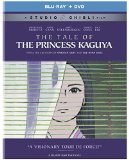| Reviews & Columns |
|
Reviews DVD TV on DVD Blu-ray 4K UHD International DVDs In Theaters Reviews by Studio Video Games Features Collector Series DVDs Easter Egg Database Interviews DVD Talk Radio Feature Articles Columns Anime Talk DVD Savant Horror DVDs The M.O.D. Squad Art House HD Talk Silent DVD
|
DVD Talk Forum |
|
|
| Resources |
|
DVD Price Search Customer Service #'s RCE Info Links |
|
Columns
|
|
|
Tale of the Princess Kaguya, The
Universal // PG // February 17, 2015
List Price: $34.98 [Buy now and save at Amazon]
The Film:
The Tale of The Princess Kaguya gathers the elements that hallmark the storied career of Isao Takahata, from the watercolor aesthetic of My Neighbors the Yamadas to the melancholy swell of emotion in Grave of the Fireflies, into one sprawling and meditative piece of artistry that could easily serve as the director's swan song if needed, and likely will be. It's the culmination of a body of work that -- outside of Takahata's consistent, heartrending reflection on the travesties of World War II -- has endured experimental highs and lows while tinkering with the balance between eccentricity and affective drama, where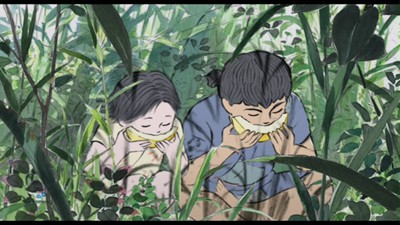 novel story ideas are given unique traits like morphing raccoon testicles and saccharine family minimalism that overshoot their mark. Through Studio Ghibli's faithful rendition of a 10th-century fable, one of Japan's oldest recorded narratives, Isao Takahata distills the successful sides of his prior films into a long-lasting journey through a mystical child's growth from a thumb-sized incarnate into a full-grown noble, whisking together broad fantasy and character intimacy into a charming, meaningful depiction of existential defiance.
novel story ideas are given unique traits like morphing raccoon testicles and saccharine family minimalism that overshoot their mark. Through Studio Ghibli's faithful rendition of a 10th-century fable, one of Japan's oldest recorded narratives, Isao Takahata distills the successful sides of his prior films into a long-lasting journey through a mystical child's growth from a thumb-sized incarnate into a full-grown noble, whisking together broad fantasy and character intimacy into a charming, meaningful depiction of existential defiance.
Like the original story, "The Tale of the Bamboo Cutter", Princess Kaguya buds into life purely through the enigmas of magic: during a woodcutter's exploration of his forest one day, he spots a bamboo shoot brightly glowing from the ground. Closer inspection reveals a tiny adult girl whom he believes to be a princess that he's intended to care for. Once he reaches his wife with the discovery, the tiny person's growth patterns kick into overdrive, morphing into a full-sized baby who undergoes rapid growth spurts before their eyes. She continues to mature far quicker than normal humans throughout her childhood, while the woodcutter discovers other magical gifts bestowed by the bamboo in his forest: the means in which to turn her into a city-dwelling noble, furthering his insistence that it's ordained by higher powers. Eventually, the time comes for the young woman to realize what appears to be her destiny, which would uproot her from a casual, rural lifestyle into one of conformation to aristocratic ideals.
Director Takahata tells the story of the future Princess Kaguya through pastel watercolor-inspired visuals with a distinct hand-drawn texture, unafraid to let portions of the image remain blank around the organic lines and shading of the focal artwork. This isn't reminiscent of the cartoonish exaggerations of The Yamadas, though: the delicateness of the aesthetic succeeds in creating an immersive, genuine atmosphere around the maturation of the young girl, paired with the recognizable eyes and jawlines of Studio Ghibli's more grounded characterizations. While it's a stunning creative realization that harkens back to historic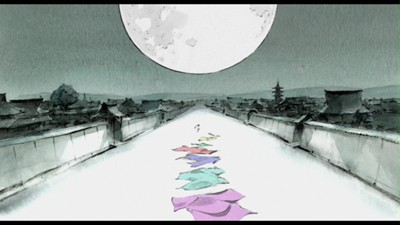 Japanese works of art, the peacefulness of the soft pastels -- paired with the elongated aims of the simple story -- occasionally pacify the film's tempo too much across its two-plus hour span, demanding patience and alertness while marveling at the strokes and subtle use of color. The editing style relishes landscapes and lingers on extended simple dramatic moments, which can be both beautiful and draining to behold depending on one's frame-of-mind.
Japanese works of art, the peacefulness of the soft pastels -- paired with the elongated aims of the simple story -- occasionally pacify the film's tempo too much across its two-plus hour span, demanding patience and alertness while marveling at the strokes and subtle use of color. The editing style relishes landscapes and lingers on extended simple dramatic moments, which can be both beautiful and draining to behold depending on one's frame-of-mind.
Discovering more about Princess Kaguya's personality becomes the film's driving force at first, where the magic surrounding her rapid growth into an adolescent is accompanied by her equally-quick development of skills befitting her body's supposed age. Takahata and co-writer Riko Sakaguchi ask the audience to simply roll with the punches of the story's mysticism, never clearly conveying the particulars of the princess' growth -- why it's so fast and when she'll stop -- as she relishes the simplicity of outdoor activities and the camaraderie of friendship with rambunctious boys. Instead, it's about gaining a grasp on what's important to the young girl: the simple, earthy delights that differentiate her from the stuffy nobility she's destined to enter, to which she absorbs as quickly as her growing-up allows. Watching how she appreciates the world around her, as well as the enigmas in how she already seems acclimated to certain things about her new world, create an intriguing vein of mystery around discovering her identity that lingers throughout the film.
Princess Kaguya truly picks up once she's sent off to live at the capital to become the film's namesake, when she's confronted with the rigid atmosphere of aristocratic life away from the relaxed freedom of home. Once she arrives, director Takahata draws out themes of resistance to the constraints put on the newly-crowned noblewoman, playing with familiar ideas built around breaking gender and societal roles as she endures the vigors of transforming into a Japanese aristocrat: changing appearance, playing music, and selecting a suitor. A downhearted tone takes over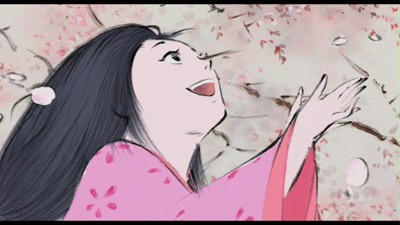 once Princess Kaguya adjusts to the notion that she's permanently detached from her pastoral existence, smartly conveying points about the prices paid for individuality and materialism that are relevant no matter the time period. It's also here that the film's visual lyricism becomes its most poignant, notably in a stunning sequence featuring Kaguya as she flees from the city and into the woods, where colorful robes blur into an abstract clustering of black and white branches.
once Princess Kaguya adjusts to the notion that she's permanently detached from her pastoral existence, smartly conveying points about the prices paid for individuality and materialism that are relevant no matter the time period. It's also here that the film's visual lyricism becomes its most poignant, notably in a stunning sequence featuring Kaguya as she flees from the city and into the woods, where colorful robes blur into an abstract clustering of black and white branches.
For a while, the mysticism of Princess Kaguya settles into the background as she distances from her rustic lifestyle and lays out unobtainable goals for her suitors, the men whose pursuit of her beauty and poise seem to be the only avenue for her perceived worth as a noblewoman. Alas, the film would be remiss without touching on the real purpose behind her emergence from the bamboo stalk, to which the tale's mystical streak comes back with a vengeance, delivering a tragic philosophical message about its themes that feels entirely at-home in the hands of the director of Grave of the Fireflies. While the grand design of the film's magical foundation seems fickle for the sake of expressing a moral, it's difficult to deny the poignancy that descends on Kaguya amid her struggle with the purpose behind her existence, ending in a marvelously sorrowful display of imagery that stays faithful to the original story's intentions. With that, The Tale of the Princess Kaguya becomes an elegiac experience not unlike viewing one of the historical tapestries rolled out before the young princess in her own story.
The Blu-ray:
Universal Home Entertainment bring The Tale of the Princess Kaguya to Blu-ray in a standard-tray three-disc package: Disc One being the Blu-ray and Disc Two being a feature-loaded DVD, while Disc Three is yet another standard-definition disc that includes the feature-length documentary Isao Takahata and His Tale of the Princess Kaguya (discussed below). A wonderful slipcover has raised lettering, a matte finish, and slightly shiny details around some of the brushstrokes in the artwork.
Video and Audio:
Put frankly, I don't see how it'd be possible to want anything more than what Universal and GKids have presented with The Tale of the Princess Kaguya on Blu-ray, starting with the utterly astonishing 1.85:1-framed, 1080p AVC visual transfer. The charcoal/pencil and watercolor aesthetic looks entirely natural and stunningly detailed: the dark outlines of faces, animals, and buildings are strong yet respectful to stroke density, while the shades of color display appropriate softness and solidity where demanded. Yet, when the colors need to pop, such as in Kaguya's robes or landscapes bathed in daylight, they're incredibly vivid and substantial. The fluctuation of shades in the backgrounds show off an impeccable grasp on gradation, where the shifts in green for foliage and brown for straw/dirt capture precisely what they're after without a single digital hiccup. The off-white coloring of the artwork's background stays appropriately solid and consistent, while paper textures are discernible and unwavering. It'd be easy to list on a laundry list of scenes to watch out for -- water falling during a rainstorm, characters eating sliced melon in dense foliage, details of flowers and branches swirling around a cherry blossom tree -- but it's easier to say that the digital treatment of this unique visual aesthetic is, in a word, perfection.
Can't really ask for much more from the audio treatments, either, presented in both the original Japanese language and an English dub through clear, robust 5.1 DTS-HD Master Audio tracks. Subtlety is, unsurprisingly, the name of the game with this track: dominant sounds include rainstorm effects and a few natural thuds from fistfight punches, which telegraph reputable, if slightly muted, force. Instead, it's the smaller effects that shine within the sound design -- the slicing of bamboo, the thump of feet on hollow hardwood floors, the twinkle of dangling jewels and the rustle of a firepit -- which are appropriately balanced at the front channels with the assertive orchestral scoring, the main culprit when it comes to full surround activity. Lots of quiet stretches are scattered throughout the film with minimal sound elements, which are free of hiss/distortion and worth relishing, while the range of dialogue stays composed in the front channels and naturally responsive to bass levels. Excellent. The English subtitle translation is impeccable, with standard white text hovering low on the image just above the film matte. French language and subtitle options are also available.
Special Features:
Along with a series of Japanese Trailers and TV Spots (13:33) and two US Trailers (3:05, 16x9 HD), the Blu-ray disc itself arrives with a lengthy Announcement of the Completion of the Film (40:09 16x9 HD), a formal affair involving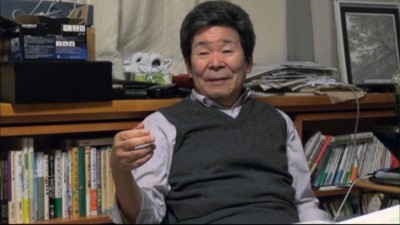 Isao Takahata and the Japanese cast and filmmakers in what initially appears to be a long-form Q&A. The content they touch on comes and goes very quickly, though, really presenting little more than a chance to put faces to names and to hear some cursory comments about their impressions of the film as a whole.
Isao Takahata and the Japanese cast and filmmakers in what initially appears to be a long-form Q&A. The content they touch on comes and goes very quickly, though, really presenting little more than a chance to put faces to names and to hear some cursory comments about their impressions of the film as a whole.
The lack of depth in the Blu-ray's features can be forgiven, sort of, because Universal have also included Isao Takahata and His Tale of the Princess Kaguya (1:25:29, 16x9), a feature-length documentary that closely and deeply follows the three-year construction of the film, on a separate DVD. The honest tempo of the feature can be discerned in the first five or six minutes of the piece, where Takahata fields pertinent questions from his collaborators about the film (What kind of movie do you want this to be? and Why does the main character do this unlikely thing?) and discusses how he didn't really intend for it to be a summary of his prior work ... but that it kinda happened anyway. After the initial segment of the making-of piece focusing on recording the dialogue before the animation, the feature later moves into a discussion about Takahata's reservation in making another film, how his inability to draw (positively) impacts his creative process, the production coexisting with The Wind Rises and its propensity to fall behind schedule. Every step is chronicled, either in the creative pit or driving between locations, with little frills or fuss outside of a few external film clips and narration. A bit drawn out, but still enjoyable.
Final Thoughts:
Isao Takahata's The Tale of the Princess Kaguya is at once striking and intimate, grand in scope and drawn-out, reverently whimsical and overly dependent on mysticism to move the story forward. Its two-and-a-half hour telling of Japan's oldest folktale comes to life through distinctive watercolor-inspired designs instead of Studio Ghibli's typical animation, resulting in gorgeous labor-intensive artwork that might be too serene at times in its elongated focus on landscapes and facial portraits. Kaguya's story might be navigated by magic, but the heart of the matter comes in her doting grasp on what the real world around her has to offer, and how she bucks social and gender conventions of the period in her continued pursuit to relish those corporeal things. Philosophical musings naturally emerge in her rushed journey from growing-up as a happy rural kid to suffering in the robes of an aristocrat, lingering all the way to the film's emotionally complicated finale that speaks to director Takahata's evocative strengths. This awe-striking film might have limited replay value, but Universal's stunning presentation of the artistry earns it a High Recommendation for being such a uniquely satisfying reference disc, and for including a strong feature-length documentary on making the film.
Thomas Spurlin, Staff Reviewer -- DVDTalk Reviews | Personal Blog/Site
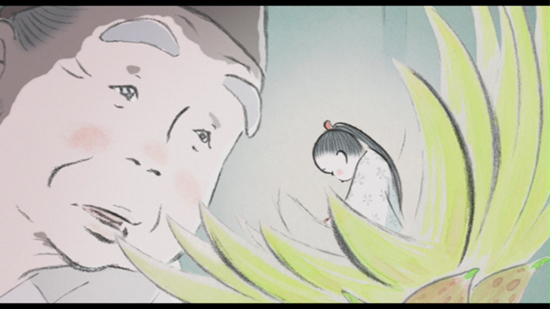 |
The Tale of The Princess Kaguya gathers the elements that hallmark the storied career of Isao Takahata, from the watercolor aesthetic of My Neighbors the Yamadas to the melancholy swell of emotion in Grave of the Fireflies, into one sprawling and meditative piece of artistry that could easily serve as the director's swan song if needed, and likely will be. It's the culmination of a body of work that -- outside of Takahata's consistent, heartrending reflection on the travesties of World War II -- has endured experimental highs and lows while tinkering with the balance between eccentricity and affective drama, where
 novel story ideas are given unique traits like morphing raccoon testicles and saccharine family minimalism that overshoot their mark. Through Studio Ghibli's faithful rendition of a 10th-century fable, one of Japan's oldest recorded narratives, Isao Takahata distills the successful sides of his prior films into a long-lasting journey through a mystical child's growth from a thumb-sized incarnate into a full-grown noble, whisking together broad fantasy and character intimacy into a charming, meaningful depiction of existential defiance.
novel story ideas are given unique traits like morphing raccoon testicles and saccharine family minimalism that overshoot their mark. Through Studio Ghibli's faithful rendition of a 10th-century fable, one of Japan's oldest recorded narratives, Isao Takahata distills the successful sides of his prior films into a long-lasting journey through a mystical child's growth from a thumb-sized incarnate into a full-grown noble, whisking together broad fantasy and character intimacy into a charming, meaningful depiction of existential defiance. Like the original story, "The Tale of the Bamboo Cutter", Princess Kaguya buds into life purely through the enigmas of magic: during a woodcutter's exploration of his forest one day, he spots a bamboo shoot brightly glowing from the ground. Closer inspection reveals a tiny adult girl whom he believes to be a princess that he's intended to care for. Once he reaches his wife with the discovery, the tiny person's growth patterns kick into overdrive, morphing into a full-sized baby who undergoes rapid growth spurts before their eyes. She continues to mature far quicker than normal humans throughout her childhood, while the woodcutter discovers other magical gifts bestowed by the bamboo in his forest: the means in which to turn her into a city-dwelling noble, furthering his insistence that it's ordained by higher powers. Eventually, the time comes for the young woman to realize what appears to be her destiny, which would uproot her from a casual, rural lifestyle into one of conformation to aristocratic ideals.
Director Takahata tells the story of the future Princess Kaguya through pastel watercolor-inspired visuals with a distinct hand-drawn texture, unafraid to let portions of the image remain blank around the organic lines and shading of the focal artwork. This isn't reminiscent of the cartoonish exaggerations of The Yamadas, though: the delicateness of the aesthetic succeeds in creating an immersive, genuine atmosphere around the maturation of the young girl, paired with the recognizable eyes and jawlines of Studio Ghibli's more grounded characterizations. While it's a stunning creative realization that harkens back to historic
 Japanese works of art, the peacefulness of the soft pastels -- paired with the elongated aims of the simple story -- occasionally pacify the film's tempo too much across its two-plus hour span, demanding patience and alertness while marveling at the strokes and subtle use of color. The editing style relishes landscapes and lingers on extended simple dramatic moments, which can be both beautiful and draining to behold depending on one's frame-of-mind.
Japanese works of art, the peacefulness of the soft pastels -- paired with the elongated aims of the simple story -- occasionally pacify the film's tempo too much across its two-plus hour span, demanding patience and alertness while marveling at the strokes and subtle use of color. The editing style relishes landscapes and lingers on extended simple dramatic moments, which can be both beautiful and draining to behold depending on one's frame-of-mind. Discovering more about Princess Kaguya's personality becomes the film's driving force at first, where the magic surrounding her rapid growth into an adolescent is accompanied by her equally-quick development of skills befitting her body's supposed age. Takahata and co-writer Riko Sakaguchi ask the audience to simply roll with the punches of the story's mysticism, never clearly conveying the particulars of the princess' growth -- why it's so fast and when she'll stop -- as she relishes the simplicity of outdoor activities and the camaraderie of friendship with rambunctious boys. Instead, it's about gaining a grasp on what's important to the young girl: the simple, earthy delights that differentiate her from the stuffy nobility she's destined to enter, to which she absorbs as quickly as her growing-up allows. Watching how she appreciates the world around her, as well as the enigmas in how she already seems acclimated to certain things about her new world, create an intriguing vein of mystery around discovering her identity that lingers throughout the film.
Princess Kaguya truly picks up once she's sent off to live at the capital to become the film's namesake, when she's confronted with the rigid atmosphere of aristocratic life away from the relaxed freedom of home. Once she arrives, director Takahata draws out themes of resistance to the constraints put on the newly-crowned noblewoman, playing with familiar ideas built around breaking gender and societal roles as she endures the vigors of transforming into a Japanese aristocrat: changing appearance, playing music, and selecting a suitor. A downhearted tone takes over
 once Princess Kaguya adjusts to the notion that she's permanently detached from her pastoral existence, smartly conveying points about the prices paid for individuality and materialism that are relevant no matter the time period. It's also here that the film's visual lyricism becomes its most poignant, notably in a stunning sequence featuring Kaguya as she flees from the city and into the woods, where colorful robes blur into an abstract clustering of black and white branches.
once Princess Kaguya adjusts to the notion that she's permanently detached from her pastoral existence, smartly conveying points about the prices paid for individuality and materialism that are relevant no matter the time period. It's also here that the film's visual lyricism becomes its most poignant, notably in a stunning sequence featuring Kaguya as she flees from the city and into the woods, where colorful robes blur into an abstract clustering of black and white branches. For a while, the mysticism of Princess Kaguya settles into the background as she distances from her rustic lifestyle and lays out unobtainable goals for her suitors, the men whose pursuit of her beauty and poise seem to be the only avenue for her perceived worth as a noblewoman. Alas, the film would be remiss without touching on the real purpose behind her emergence from the bamboo stalk, to which the tale's mystical streak comes back with a vengeance, delivering a tragic philosophical message about its themes that feels entirely at-home in the hands of the director of Grave of the Fireflies. While the grand design of the film's magical foundation seems fickle for the sake of expressing a moral, it's difficult to deny the poignancy that descends on Kaguya amid her struggle with the purpose behind her existence, ending in a marvelously sorrowful display of imagery that stays faithful to the original story's intentions. With that, The Tale of the Princess Kaguya becomes an elegiac experience not unlike viewing one of the historical tapestries rolled out before the young princess in her own story.
The Blu-ray:
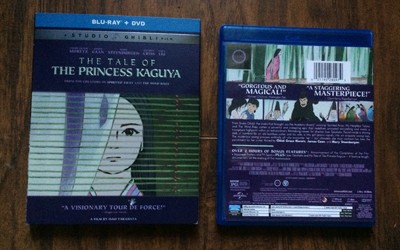 | 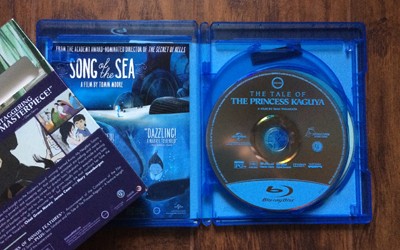 |
Universal Home Entertainment bring The Tale of the Princess Kaguya to Blu-ray in a standard-tray three-disc package: Disc One being the Blu-ray and Disc Two being a feature-loaded DVD, while Disc Three is yet another standard-definition disc that includes the feature-length documentary Isao Takahata and His Tale of the Princess Kaguya (discussed below). A wonderful slipcover has raised lettering, a matte finish, and slightly shiny details around some of the brushstrokes in the artwork.
Video and Audio:
Put frankly, I don't see how it'd be possible to want anything more than what Universal and GKids have presented with The Tale of the Princess Kaguya on Blu-ray, starting with the utterly astonishing 1.85:1-framed, 1080p AVC visual transfer. The charcoal/pencil and watercolor aesthetic looks entirely natural and stunningly detailed: the dark outlines of faces, animals, and buildings are strong yet respectful to stroke density, while the shades of color display appropriate softness and solidity where demanded. Yet, when the colors need to pop, such as in Kaguya's robes or landscapes bathed in daylight, they're incredibly vivid and substantial. The fluctuation of shades in the backgrounds show off an impeccable grasp on gradation, where the shifts in green for foliage and brown for straw/dirt capture precisely what they're after without a single digital hiccup. The off-white coloring of the artwork's background stays appropriately solid and consistent, while paper textures are discernible and unwavering. It'd be easy to list on a laundry list of scenes to watch out for -- water falling during a rainstorm, characters eating sliced melon in dense foliage, details of flowers and branches swirling around a cherry blossom tree -- but it's easier to say that the digital treatment of this unique visual aesthetic is, in a word, perfection.
Can't really ask for much more from the audio treatments, either, presented in both the original Japanese language and an English dub through clear, robust 5.1 DTS-HD Master Audio tracks. Subtlety is, unsurprisingly, the name of the game with this track: dominant sounds include rainstorm effects and a few natural thuds from fistfight punches, which telegraph reputable, if slightly muted, force. Instead, it's the smaller effects that shine within the sound design -- the slicing of bamboo, the thump of feet on hollow hardwood floors, the twinkle of dangling jewels and the rustle of a firepit -- which are appropriately balanced at the front channels with the assertive orchestral scoring, the main culprit when it comes to full surround activity. Lots of quiet stretches are scattered throughout the film with minimal sound elements, which are free of hiss/distortion and worth relishing, while the range of dialogue stays composed in the front channels and naturally responsive to bass levels. Excellent. The English subtitle translation is impeccable, with standard white text hovering low on the image just above the film matte. French language and subtitle options are also available.
Special Features:
Along with a series of Japanese Trailers and TV Spots (13:33) and two US Trailers (3:05, 16x9 HD), the Blu-ray disc itself arrives with a lengthy Announcement of the Completion of the Film (40:09 16x9 HD), a formal affair involving
 Isao Takahata and the Japanese cast and filmmakers in what initially appears to be a long-form Q&A. The content they touch on comes and goes very quickly, though, really presenting little more than a chance to put faces to names and to hear some cursory comments about their impressions of the film as a whole.
Isao Takahata and the Japanese cast and filmmakers in what initially appears to be a long-form Q&A. The content they touch on comes and goes very quickly, though, really presenting little more than a chance to put faces to names and to hear some cursory comments about their impressions of the film as a whole. The lack of depth in the Blu-ray's features can be forgiven, sort of, because Universal have also included Isao Takahata and His Tale of the Princess Kaguya (1:25:29, 16x9), a feature-length documentary that closely and deeply follows the three-year construction of the film, on a separate DVD. The honest tempo of the feature can be discerned in the first five or six minutes of the piece, where Takahata fields pertinent questions from his collaborators about the film (What kind of movie do you want this to be? and Why does the main character do this unlikely thing?) and discusses how he didn't really intend for it to be a summary of his prior work ... but that it kinda happened anyway. After the initial segment of the making-of piece focusing on recording the dialogue before the animation, the feature later moves into a discussion about Takahata's reservation in making another film, how his inability to draw (positively) impacts his creative process, the production coexisting with The Wind Rises and its propensity to fall behind schedule. Every step is chronicled, either in the creative pit or driving between locations, with little frills or fuss outside of a few external film clips and narration. A bit drawn out, but still enjoyable.
Final Thoughts:
Isao Takahata's The Tale of the Princess Kaguya is at once striking and intimate, grand in scope and drawn-out, reverently whimsical and overly dependent on mysticism to move the story forward. Its two-and-a-half hour telling of Japan's oldest folktale comes to life through distinctive watercolor-inspired designs instead of Studio Ghibli's typical animation, resulting in gorgeous labor-intensive artwork that might be too serene at times in its elongated focus on landscapes and facial portraits. Kaguya's story might be navigated by magic, but the heart of the matter comes in her doting grasp on what the real world around her has to offer, and how she bucks social and gender conventions of the period in her continued pursuit to relish those corporeal things. Philosophical musings naturally emerge in her rushed journey from growing-up as a happy rural kid to suffering in the robes of an aristocrat, lingering all the way to the film's emotionally complicated finale that speaks to director Takahata's evocative strengths. This awe-striking film might have limited replay value, but Universal's stunning presentation of the artistry earns it a High Recommendation for being such a uniquely satisfying reference disc, and for including a strong feature-length documentary on making the film.
|
| Popular Reviews |
| Sponsored Links |
|
|
| Sponsored Links |
|
|
| Release List | Reviews | Shop | Newsletter | Forum | DVD Giveaways | Blu-Ray | Advertise |
|
Copyright 2024 DVDTalk.com All Rights Reserved. Legal Info, Privacy Policy, Terms of Use,
Manage Preferences,
Your Privacy Choices | |||||||









